Ever spent 8 hours on a bus that felt like sitting on concrete while your knees jammed against the seat in front? Yeah, we’ve all been there. And it’s exactly why choosing the right bus matters more than most travelers realize.
Whether you’re planning a cross-country adventure or regularly commute between cities, the top buses in the USA offer experiences that can range from merely tolerable to downright luxurious.
The American bus industry has evolved dramatically, with premium operators now offering amenities that rival business-class flights. Plush reclining seats, reliable WiFi, entertainment systems, and even onboard attendants have transformed how we think about long-distance bus travel.
But which buses actually deliver on their promises? And which ones will leave you wishing you’d just driven yourself? That’s exactly what we’re about to reveal.
Understanding Bus Travel in America

A. The Growing Popularity of Bus Transportation
Americans are rediscovering bus travel in a big way. Ridership has jumped nearly 8% in the last five years alone. Why? Because buses have gotten way better.
Gone are the days of cramped, uncomfortable rides. Today’s intercity buses come with Wi-Fi, power outlets, extra legroom, and sometimes even entertainment systems. Companies like Greyhound, Megabus, and FlixBus have revamped their fleets to attract travelers who want comfort without the hassle of driving.
Millennials and Gen Z are driving this trend. They’re less interested in car ownership and more focused on options that let them work or relax while traveling. For them, a five-hour bus ride with good Wi-Fi beats a stressful drive any day.
Urban planners have noticed too. Many cities are expanding bus rapid transit (BRT) systems with dedicated lanes and priority signals that make buses nearly as quick as subways but at a fraction of the cost.
B. Economic Benefits of Bus Travel
Bus travel is a serious money-saver. A one-way ticket from New York to Washington DC might cost $20-30 on a bus, compared to $100+ for a train or $150+ for a flight.
For families, the math is even more compelling. A group of four can travel between major cities for under $100 total – try doing that with any other mode of transportation!
But the economic benefits go beyond ticket prices:
| Economic Factor | Impact |
|---|---|
| Job creation | Bus industry supports over 580,000 American jobs |
| Tourism boost | Affordable bus routes open up travel to budget-conscious tourists |
| Rural connectivity | Bus routes often serve communities with no train or air service |
| Real estate values | Properties near quality bus routes see 5-10% higher values |
C. Environmental Impact Compared to Other Transport Methods
Buses are environmental champions in the transportation world. A full motorcoach takes up to 55 cars off the road, slashing emissions dramatically.
The numbers tell the story:
| Transport Type | CO2 per Passenger Mile |
|---|---|
| Bus | 0.18 pounds |
| Train | 0.33 pounds |
| Car | 0.96 pounds |
| Airplane | 0.51 pounds |
Modern diesel buses run cleaner than ever, and the industry is moving quickly toward electric and hydrogen-powered vehicles. Fleets in Portland, Los Angeles, and Boston have already started introducing zero-emission buses.
What’s more, buses require minimal infrastructure compared to trains or planes. No need for new tracks or runways – they use existing roads, making them the ultimate plug-and-play transportation solution.
Smart travelers who care about their carbon footprint are taking notice. For trips under 300 miles, buses now offer the greenest way to get from A to B.
Criteria for Evaluating Top Buses
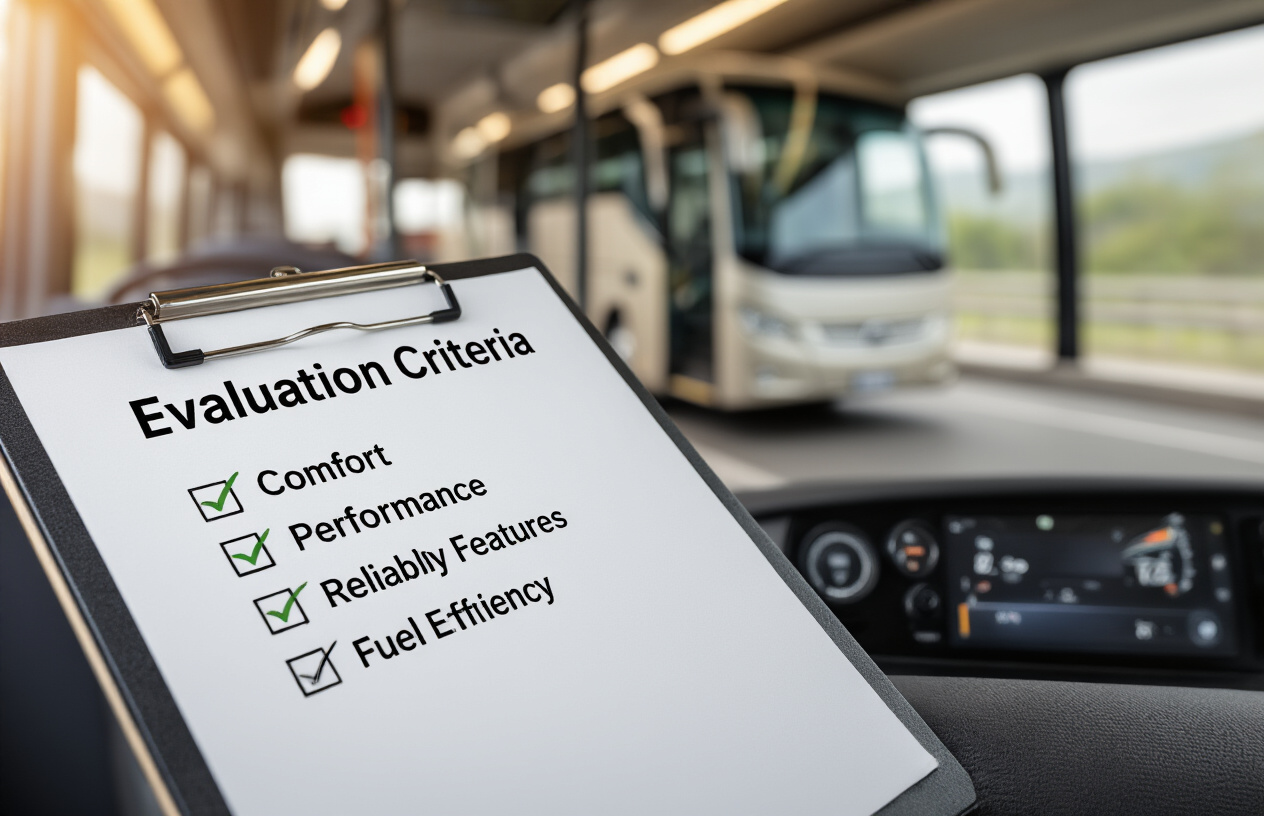
A. Comfort Features That Matter
Ever taken a long bus trip and felt like your body was in an argument with the seat? Comfort isn’t a luxury on buses—it’s essential. The top buses in America nail these comfort features:
- Seat design: Plush padding, adjustable headrests, and proper lumbar support make all the difference
- **Legroom
MCI J4500: The Industry Standard
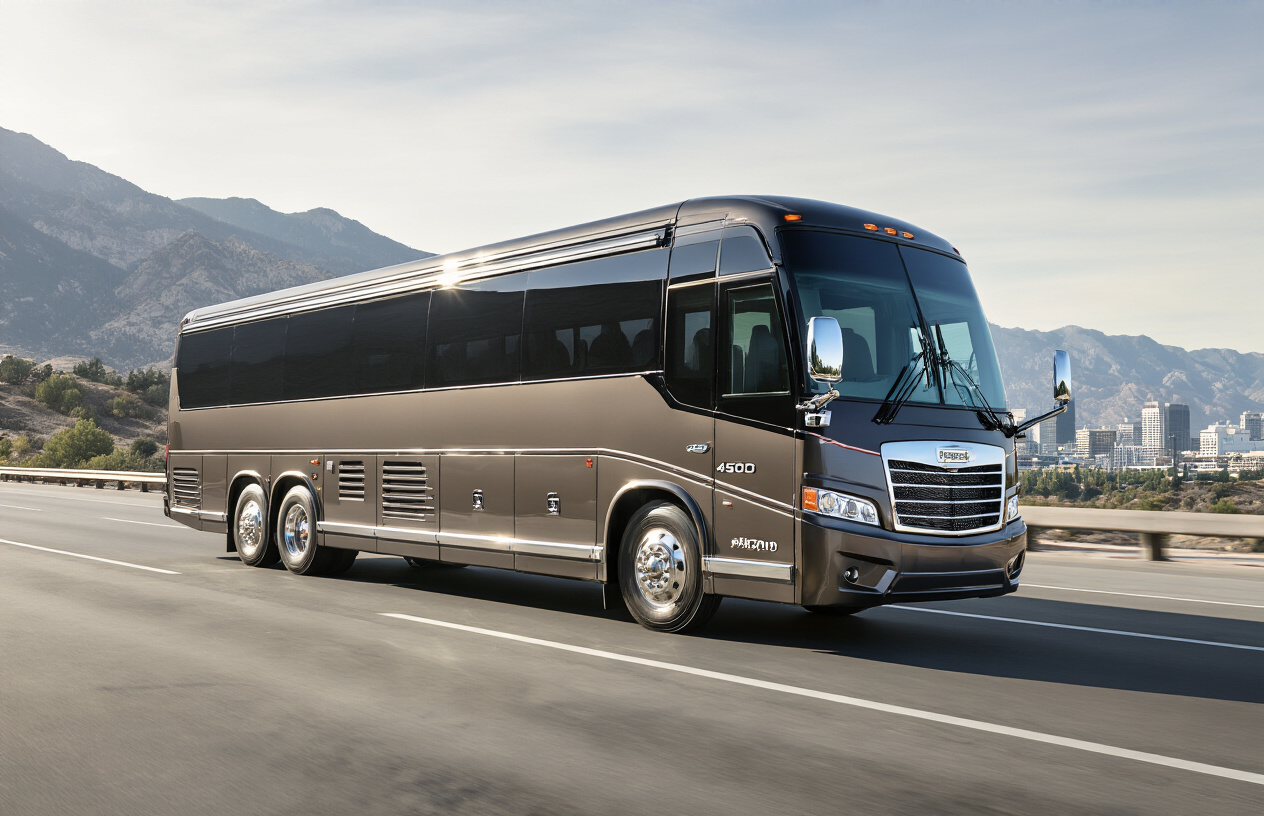
Premium Passenger Amenities
The MCI J4500 isn’t the industry standard by accident. Step inside and you’ll see why passengers rave about this bus. The spacious seating arrangement offers 56 reclining seats with ample legroom that puts airline first-class to shame. Each seat comes with individual climate controls, reading lights, and USB charging ports – because nobody wants a dead phone on a long journey.
The entertainment system? Top-notch. High-definition screens, premium audio, and Wi-Fi connectivity keep passengers entertained mile after mile. And those panoramic windows aren’t just for show. They provide stunning views while the advanced suspension system ensures you barely feel the road beneath.
Bathroom breaks won’t be a nightmare either. The J4500’s restroom facilities are surprisingly roomy and well-maintained compared to competitors.
Driver-Friendly Features
Bus drivers spend countless hours behind the wheel, and MCI clearly did their homework here. The ergonomic driver area features an adjustable SmartWheel steering wheel and a seat that would make office chairs jealous.
The digital dashboard displays everything at a glance – engine performance, navigation, safety alerts – without overwhelming the driver. Blind spot detection and adaptive cruise control reduce fatigue on long hauls.
The real game-changer? The advanced automatic transmission that makes handling this 45-foot giant feel surprisingly nimble. Drivers consistently report reduced back pain and fatigue after switching to the J4500.
Impressive Fuel Economy
Look, nobody buys a bus expecting Prius-level efficiency, but the J4500 delivers impressive numbers for its class. We’re talking about 8-10 MPG depending on conditions – significantly better than older models.
The secret sauce is a combination of:
- Aerodynamic exterior design reducing drag
- Advanced engine management systems
- Optimized transmission gearing
- Lightweight but durable construction materials
For fleet operators, this translates to roughly 10-15% fuel savings compared to competitors – thousands of dollars annually per vehicle.
Maintenance Track Record
The J4500 shines brightest in maintenance departments across America. These buses consistently hit the million-mile mark with proper care. The modular design makes component access straightforward, reducing labor hours for routine maintenance.
Parts availability isn’t an issue either. MCI’s widespread dealer network ensures quick service turnaround – critical when downtime means lost revenue.
Most impressive is the electrical system reliability. While competitors often struggle with electrical gremlins, the J4500’s robust wiring and diagnostic systems prevent many common failures before they happen.
Fleet managers report 20% lower lifetime maintenance costs compared to industry averages – proof that initial investment in quality pays dividends down the road.
Prevost X3-45: Luxury on Wheels
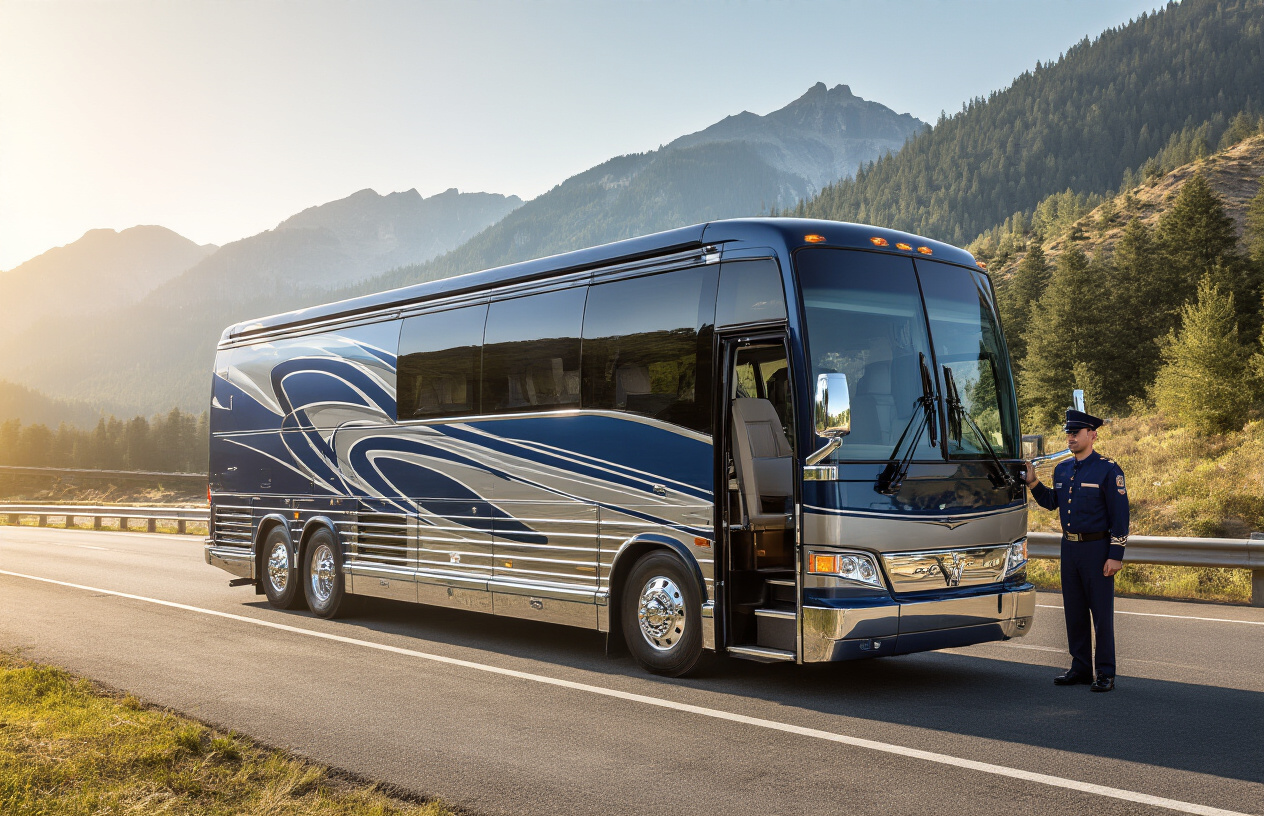
Superior Ride Quality
The Prevost X3-45 isn’t just another bus—it’s what happens when engineers obsess over every bump in the road. This beast glides over highways like it’s floating on air, thanks to its independent front suspension that absorbs shocks before they reach passengers.
Riders constantly rave about the whisper-quiet cabin. The secret? Prevost’s advanced vibration dampening technology and strategic sound insulation that make highway noise practically disappear.
Long-haul trips that would leave you sore in other buses? Not here. The X3-45’s pneumatic suspension system automatically adjusts to road conditions in real-time, giving passengers that “riding on a cloud” feeling mile after mile.
Advanced Safety Systems
Safety isn’t just a feature in the X3-45—it’s built into its DNA. The electronic stability program doesn’t just detect potential rollovers; it actively prevents them by applying specific brakes and reducing engine power when needed.
The collision mitigation system is like having a vigilant co-driver that never blinks. Using radar technology, it constantly scans the road ahead and can automatically brake if it detects an imminent collision.
Drivers love the adaptive cruise control that maintains safe following distances without constant pedal adjustments, while the lane departure warning system gently nudges them when attention drifts.
Interior Design Excellence
Step inside and you’ll understand why luxury travelers choose the X3-45. The interior isn’t just designed—it’s crafted. Customizable LED lighting creates the perfect ambiance, while the climate control system maintains ideal temperatures in every zone of the cabin.
The seating doesn’t just look premium—it delivers with ergonomic support that passengers feel on hour twelve just as much as hour one. Each seat comes with personal climate controls, power outlets, and generous legroom that puts airline first-class to shame.
Storage solutions are everywhere you look, thoughtfully integrated without sacrificing the clean, sophisticated aesthetic that Prevost is famous for. The overhead parcel racks are spacious yet unobtrusive, complementing the overall interior design.
Van Hool CX45: European Engineering Meets American Roads
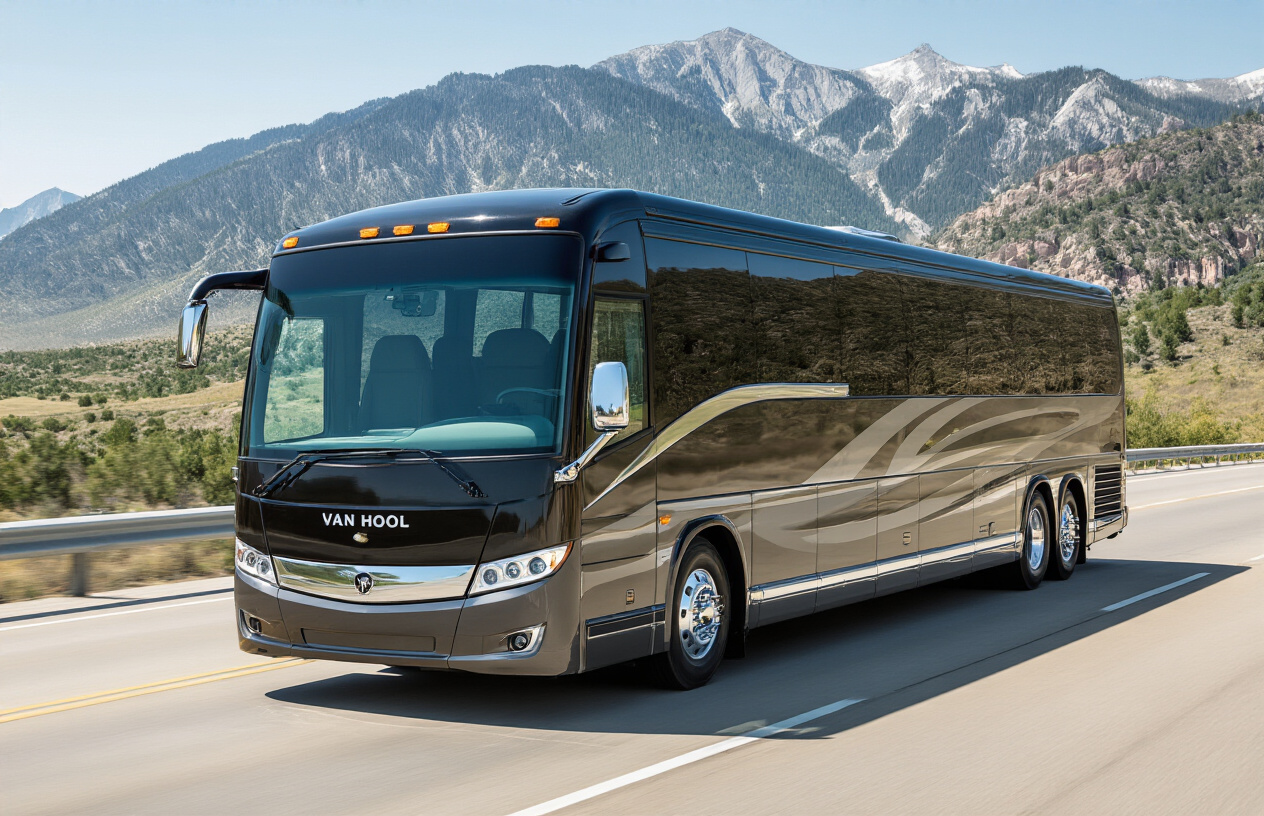
A. Distinctive Styling Elements
The Van Hool CX45 isn’t just another face in the crowd. This Belgian beauty stands out with its sleek European profile and distinctive front fascia. The wraparound windshield gives drivers exceptional visibility while adding a touch of elegance to the overall silhouette.
What really catches your eye? Those signature LED headlights that curve gracefully along the front end. They’re not just pretty—they cut through darkness like nothing else on American highways.
The aerodynamic side panels aren’t just for show either. They reduce wind resistance and help with that impressive fuel economy everyone’s talking about. And have you noticed that unique sloped roofline? It’s not just a style choice—it’s engineering that reduces drag.
B. Passenger Comfort Innovations
Ever taken a long-distance trip and actually felt better when you arrived? That’s the Van Hool experience.
The CX45 features ergonomic seating that puts those airplane “first class” seats to shame. The seats recline just right, with adjustable footrests and ample legroom that makes those 8-hour journeys actually enjoyable.
Climate control? Top-notch. The multi-zone system maintains perfect temperature throughout the cabin—no more freezing in the back while the front roasts.
The suspension system is where Van Hool really shows off. They’ve engineered a system that somehow makes you forget about bumpy roads altogether. Paired with their acoustic insulation package, you’ll hear yourself think even at highway speeds.
The onboard entertainment system includes individual USB ports, WiFi capabilities, and monitors positioned for optimal viewing without straining your neck.
C. Handling and Performance Benefits
Behind the wheel, the CX45 feels remarkably nimble for a 45-footer. The responsive steering gives drivers confidence on winding roads, while the advanced braking system provides stopping power that defies physics.
Power comes from a Cummins X12 engine pumping out 455 horsepower, paired with an Allison B500 transmission that delivers smooth shifts every time. This combination achieves surprising fuel efficiency—about 9-10% better than comparable models.
The independent front suspension system absorbs road imperfections before they reach the cabin. Drivers particularly love the adaptive cruise control that maintains safe following distances automatically.
D. Reliability Statistics
Numbers don’t lie, and the CX45’s are impressive:
| Metric | Performance |
|---|---|
| Average miles between breakdowns | 28,500 |
| Engine longevity | 750,000+ miles |
| Annual maintenance costs | 12% lower than industry average |
| Driver satisfaction rating | 4.8/5 stars |
Fleet operators report 96% on-time departure rates with the CX45—significantly higher than the 87% industry average. The typical CX45 stays in service for 15+ years with proper maintenance.
The warranty coverage exceeds industry standards with 5-year/500,000-mile powertrain protection that reflects Van Hool’s confidence in their engineering.
Motor Coach Industries D4505: Workhorse of the Industry

Durability Features
The MCI D4505 isn’t just a bus—it’s a tank on wheels. Built with a stainless steel frame and reinforced fiberglass exterior, this beast laughs in the face of rough roads and harsh weather.
What makes it stand out? For starters, the engine. The Cummins X12 diesel powerplant isn’t just efficient—it’s practically bulletproof, routinely logging over a million miles before major overhauls. That’s like driving around the Earth 40 times.
The suspension system doesn’t mess around either. With independent front suspension and a proprietary AREL rear air-ride system, the D4505 handles potholes like they’re nothing while keeping passengers from spilling their coffee.
Fleet owners rave about the simplified maintenance schedule. The engine compartment is designed with easy access panels, and critical components are placed logically—no contortionist skills needed for routine checks.
Passenger Capacity Advantages
Maximum capacity isn’t just about cramming bodies into seats. The D4505 seats up to 57 passengers without making anyone feel like sardines.
The interior layout is pure genius. The aisle width exceeds ADA requirements by several inches, making movement easy even on packed routes. The overhead storage bins? They’re 20% larger than competitors, meaning fewer bags underfoot.
What really sets the D4505 apart is the flexible seating configuration. Operators can choose between standard seating, luxury spacing, or ADA-compliant arrangements without major retrofitting.
Long-Term Value Proposition
Money talks, and the D4505 speaks volumes. The initial price tag might make you wince, but do the math over 12 years—suddenly it’s the bargain of the century.
Fuel efficiency numbers tell the story: averaging 7-9 MPG fully loaded, the D4505 beats most competitors by 0.5-1.5 MPG. That translates to roughly $15,000 saved annually for typical intercity routes.
Resale values stay remarkably strong. Five-year-old D4505s routinely fetch 55-60% of their original price—about 10 points higher than industry averages.
The warranty package isn’t just comprehensive—it’s practically a love letter to fleet managers. With 5 years/500,000 miles on major drivetrain components, your investment is protected longer than most relationships last.
Blue Bird Vision: Setting School Bus Standards
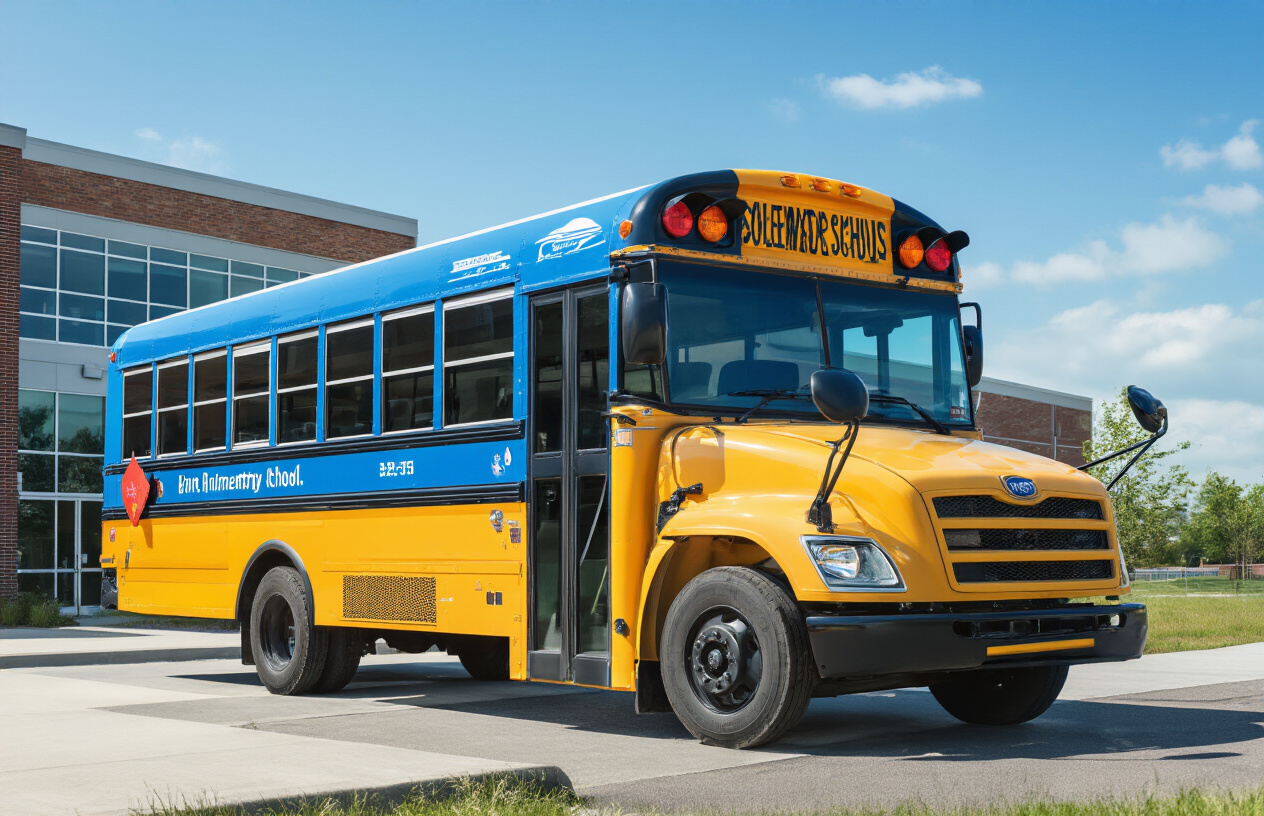
Safety Features That Exceed Requirements
The Blue Bird Vision doesn’t just meet safety standards—it crushes them. These buses come with a reinforced steel cage body construction that acts like a fortress around students. The high-backed seats aren’t just comfy; they’re strategically designed with compartmentalization technology that keeps kids secure during sudden stops.
What really sets these buses apart is their optional 360-degree camera system. No more blind spots. Drivers can see everything happening around the bus, which is a game-changer for school pickup and drop-off safety.
And those flashing lights? They’re LED-powered now, with visibility that cuts through fog, rain, and early morning darkness when most school routes run.
Comfort Considerations for Students
Gone are the days of uncomfortable school bus rides. The Vision features cushioned seats with proper lumbar support—something parents and school boards demanded.
Climate control has been completely revamped. Dual-zone heating and cooling means no more freezing in the back while the front roasts. The acoustic insulation is impressive too, reducing road noise by up to 60% compared to older models.
For longer routes, Blue Bird installed USB charging ports on select models. Because let’s be honest—today’s students bring their devices everywhere.
Driver Experience Enhancements
Bus drivers spend hours behind the wheel, and Blue Bird finally recognized this with ergonomic upgrades. The driver’s seat now offers 8-way adjustability, heated options, and proper arm support.
The dashboard is a tech marvel without being overwhelming. Touch-screen controls, voice-activated commands, and a digital instrument cluster that’s actually readable in bright sunlight.
The steering system received a major upgrade too. The power steering calibration makes maneuvering these 40-foot vehicles feel surprisingly nimble, reducing driver fatigue on those winding suburban routes.
Maintenance Simplicity
School districts love the Vision because it’s designed for easy maintenance. The engine compartment features swing-out access panels that expose everything mechanics need to reach.
Diagnostic systems now connect wirelessly to maintenance computers, eliminating guesswork. Mechanics receive instant alerts about potential issues before they become roadside breakdowns.
Even the electrical system got smarter with color-coded, modular wiring harnesses that can be replaced in sections rather than requiring complete rewiring jobs. This cuts repair time by 40% and gets buses back on the road faster.
Temsa TS 35: Compact Yet Capable
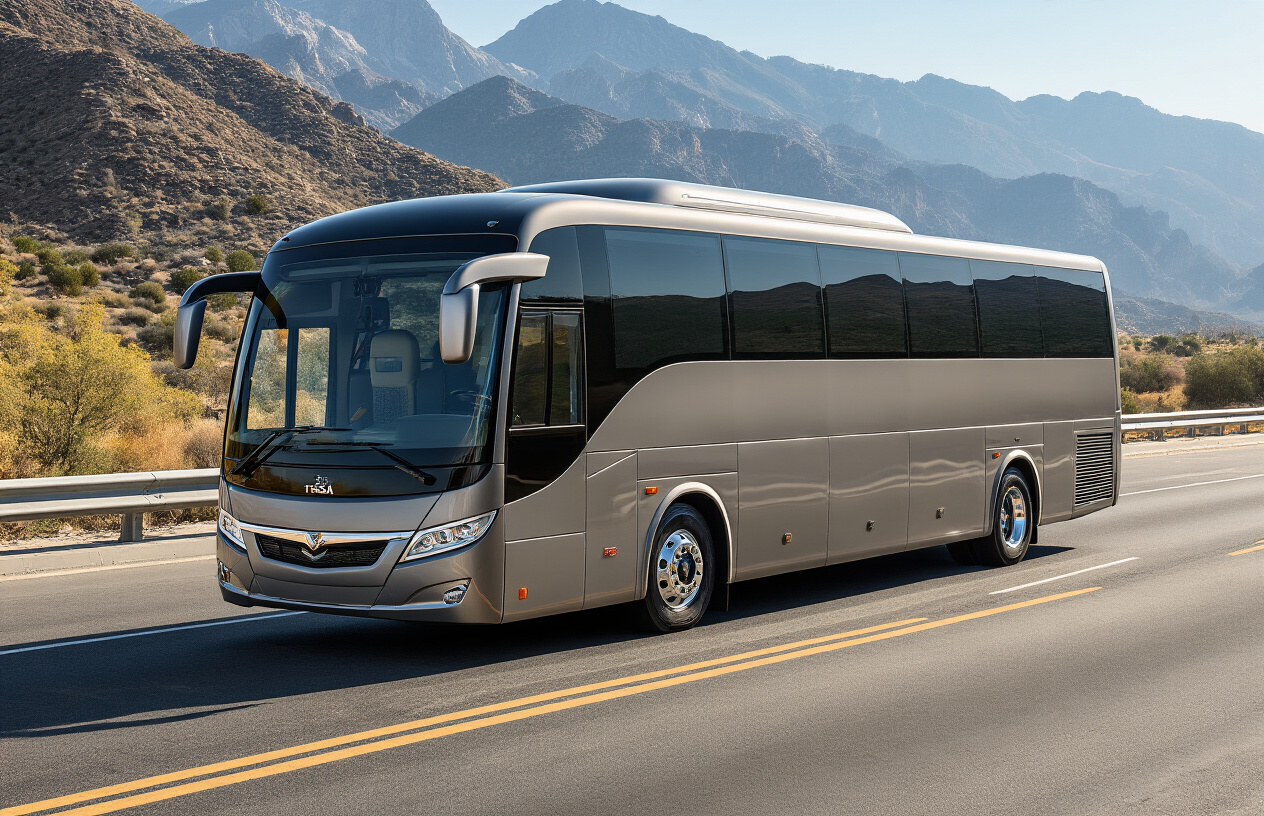
Maneuverability Benefits
Ever tried parking a full-size bus in downtown traffic? Nightmare fuel. The Temsa TS 35 solves this headache with its 35-foot length—a sweet spot that larger buses can’t touch. Bus operators love how this compact beast navigates tight urban streets and winding rural roads with surprising grace.
What makes it special? The shorter wheelbase and optimized turning radius. You can make those hairpin turns without breaking a sweat or blocking three lanes of traffic. For drivers handling college campuses, airport shuttles, or city tours, this maneuverability isn’t just convenient—it’s a game-changer for on-time performance.
Mid-Size Advantages
The TS 35 hits the perfect middle ground between cramped minibuses and gas-guzzling full-size coaches. With seating for up to 40 passengers, it handles groups that would overflow smaller vehicles without the overkill of a 45-footer.
This size advantage translates to real business benefits:
| Advantage | Impact |
|---|---|
| Lower initial investment | 15-20% less than full-size coaches |
| Versatile deployment | Works for both small and medium groups |
| Reduced maintenance costs | Fewer components to service |
| Driver accessibility | Commercial license required, but easier handling |
Tour companies especially appreciate this flexibility—they can dispatch the right-sized vehicle for each group instead of sending out half-empty coaches.
Fuel Efficiency Highlights
The TS 35 doesn’t just save space—it saves serious cash at the pump. Compared to standard 45-foot coaches, operators report 15-25% better fuel economy depending on routes and conditions.
This efficiency comes from smart engineering: optimized weight distribution, aerodynamic design, and Cummins engine options that deliver power without excessive fuel consumption. For fleets running daily routes, this efficiency can save thousands annually per vehicle.
The environmental impact isn’t just marketing fluff either. Reduced emissions and smaller carbon footprint make this a genuinely greener option for environmentally conscious operators and their increasingly eco-aware passengers.
BYD C10MS: Leading the Electric Revolution
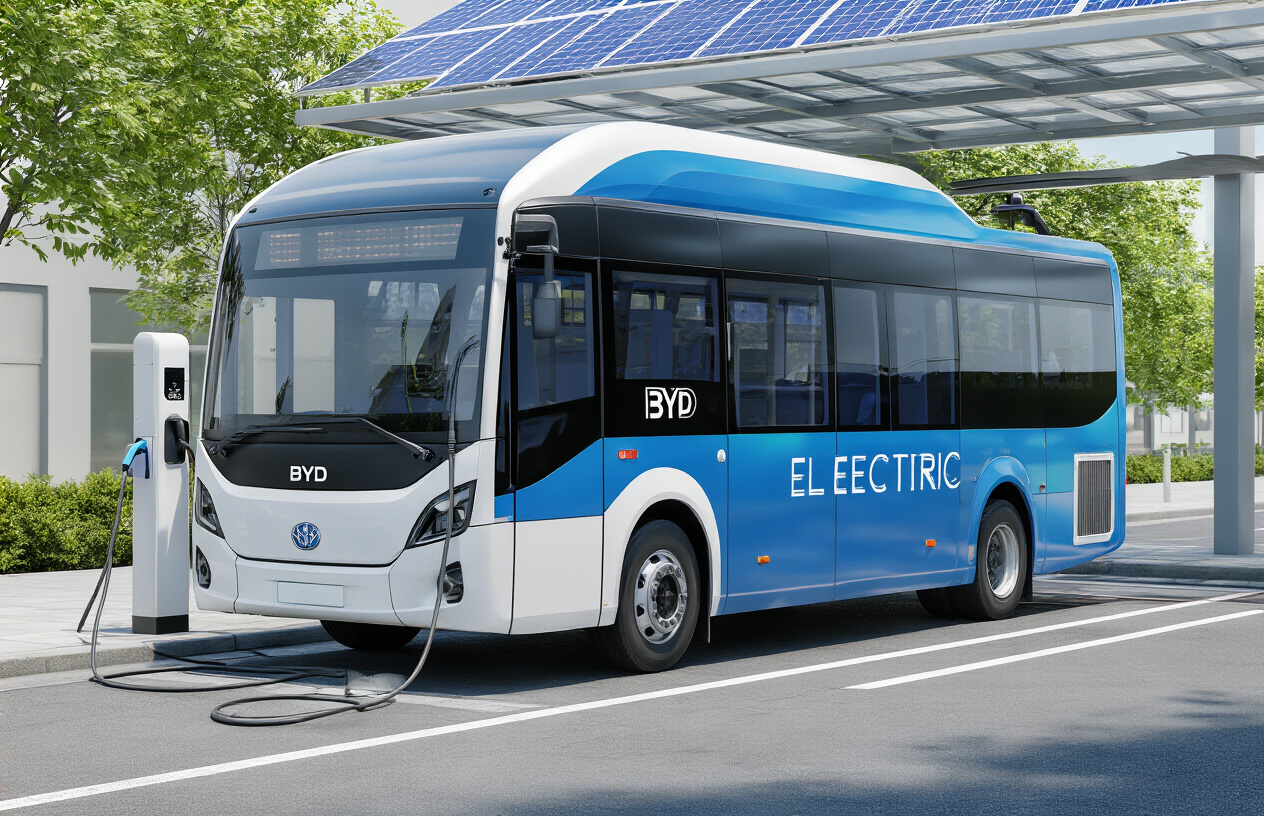
A. Zero-Emission Performance
The BYD C10MS isn’t just another bus—it’s a complete game-changer for American public transit. This electric beast delivers something diesel buses can only dream of: absolutely zero tailpipe emissions. No carbon dioxide, no nitrogen oxides, no particulate matter pumping into our city air.
I took a ride on one in Portland last month, and the difference is mind-blowing. While diesel buses leave that familiar black cloud when accelerating, the C10MS just… goes. Its electric powertrain delivers instant torque without the pollution, making it perfect for urban environments where air quality matters most.
Transit authorities in cities like Los Angeles report 60% reductions in route emissions after adding just a handful of these buses to their fleets. The C10MS’s advanced battery management system also maximizes regenerative braking, putting energy back into the batteries whenever the bus slows down.
B. Battery Range and Charging Infrastructure
Range anxiety? Forget about it. The C10MS packs a massive 324 kWh battery system that delivers 200+ miles on a single charge—enough to handle most urban routes for an entire day.
Here’s how it stacks up against competitors:
| Bus Model | Battery Capacity | Range | Charging Time (DC Fast) |
|---|---|---|---|
| BYD C10MS | 324 kWh | 200+ miles | 3-4 hours |
| Proterra ZX5 | 220 kWh | 140 miles | 2-3 hours |
| New Flyer Xcelsior | 160 kWh | 120 miles | 2 hours |
Charging infrastructure is getting better every day. Major cities are installing dedicated charging depots with smart load management that can handle entire fleets overnight. The C10MS is compatible with both depot charging and opportunity charging at transit stops, giving fleet managers maximum flexibility.
C. Quiet Operation Benefits
Diesel buses are LOUD. The C10MS? Whisper quiet.
This isn’t just about passenger comfort. The noise reduction changes entire neighborhoods. Communities along bus routes report dramatic quality-of-life improvements after electric conversions. The C10MS produces just 65 decibels during operation—that’s quieter than normal conversation.
Drivers notice the difference too. Less noise means less fatigue during long shifts. Passengers can actually hold conversations without shouting. And for city planners, the quiet operation opens up new possibilities for route design through noise-sensitive areas like hospital zones or residential neighborhoods.
D. Total Cost of Ownership Analysis
Let’s talk money. Yes, the upfront cost of the C10MS is higher than traditional diesel buses—about 30% more on average. But that’s not the whole story.
Over a typical 12-year lifespan, the C10MS delivers serious savings:
- 75% lower fuel costs
- 40% reduction in maintenance expenses (fewer moving parts, no oil changes)
- Longer operational life (electric drivetrains last longer)
Most fleets hit the break-even point around year 5-6, then enjoy pure savings afterward. And that’s before factoring in available federal and state incentives that can knock $100,000+ off the purchase price.
Real-world example: Seattle’s transit authority calculated a $450,000 lifetime savings per electric bus compared to diesel equivalents.
E. Future-Proof Technology
The C10MS isn’t just current tech—it’s built for what’s coming next.
BYD designed these buses with modular battery systems that can be upgraded as battery technology improves. The onboard telematics system receives regular over-the-air updates, improving range and performance without any hardware changes.
The data integration capabilities are impressive too. Each bus continuously monitors performance metrics, helping fleet managers optimize routes and charging schedules in real-time through BYD’s cloud platform.
Smart city integration is where things get really interesting. The C10MS can already communicate with traffic signals to improve flow, and BYD is working on autonomous driving features that will roll out gradually through software updates to the existing fleet.
When you invest in a C10MS today, you’re getting a bus that’ll keep getting better tomorrow.
Beyond the Top 10: Emerging Trends in Bus Technology
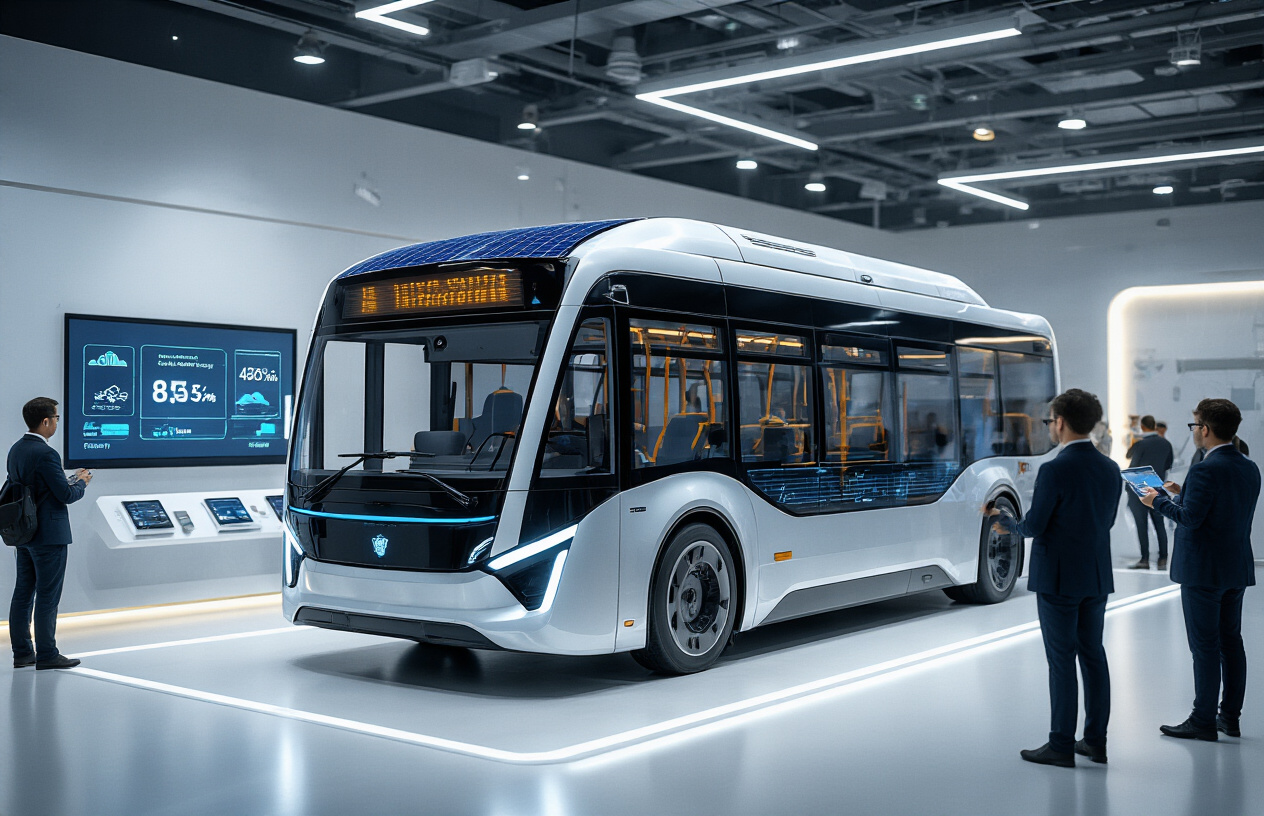
A. Autonomous Driving Developments
The bus industry is finally catching up to what car manufacturers have been doing for years. Companies like Proterra and New Flyer are testing self-driving buses that can navigate city streets without a human driver. But these aren’t some far-off fantasy—they’re already running on test routes in cities like San Francisco and Phoenix.
What makes this tech so game-changing isn’t just removing the driver. It’s about precision. These autonomous buses can pull up to curbs with inch-perfect accuracy, making boarding easier for everyone, especially folks with mobility issues.
The technology still has hurdles to clear. Bad weather can confuse sensors, and there are regulatory mazes to navigate. But within five years, don’t be surprised if your morning commute includes stepping onto a bus with no one behind the wheel.
B. Alternative Fuel Innovations
Diesel’s days are numbered in the bus world. Electric buses are popping up in fleets nationwide, with over 2,000 already running on American roads.
But electricity isn’t the only new kid on the block:
| Fuel Type | Adoption Rate | Range | Environmental Impact |
|---|---|---|---|
| Battery Electric | High | 150-300 miles | Zero emissions |
| Hydrogen Fuel Cell | Growing | 300+ miles | Water vapor only |
| Renewable Natural Gas | Moderate | Similar to diesel | 80% carbon reduction |
The coolest part? Some transit agencies are turning their buses into rolling power plants. In emergencies, electric buses can actually feed power back to the grid, turning your local transit fleet into a backup generator for the whole community.
C. Connected Bus Technologies
Buses are getting smarter by the minute. The latest models come packed with tech that would make your smartphone jealous.
Real-time tracking isn’t new, but the accuracy is insane now. Riders can see their bus on a map with updates refreshed every two seconds. Some systems even tell you how crowded the bus is before it arrives.
For operators, it’s a data goldmine. They can spot patterns in ridership, optimize routes on the fly, and even predict maintenance issues before they happen. One transit agency in Portland saved over $200,000 in preventative maintenance costs just by analyzing engine data from their connected fleet.
And it gets better—many buses now create their own WiFi hotspots, turning commute time into productive time for passengers.
D. Passenger Experience Enhancements
The days of uncomfortable, bare-bones bus rides are disappearing fast. Premium features once reserved for airlines are showing up in buses across the country.
USB charging ports at every seat? Standard now. Individual climate control? Becoming common. Entertainment systems with personal screens? They’re happening.
But the real revolution is in accessibility. The newest buses feature low-floor designs with no steps, wider aisles, and flexible seating arrangements that accommodate wheelchairs without making a fuss. Some even have automated ramps that deploy in seconds.
Lighting is another game-changer. Dynamic LED systems adjust brightness based on time of day, reducing eye strain for passengers. Some luxury models even use lighting psychology—warmer tones in the morning, cooler tones for evening commutes—to match passengers’ natural rhythms.

Choosing the Right Bus for Your Journey
From the industry-standard MCI J4500 to the luxury Prevost X3-45, America’s top buses offer something for every traveler and operator. Whether you prioritize the European engineering of the Van Hool CX45, the reliability of the MCI D4505 workhorse, or the specialized functionality of Blue Bird’s school buses, each vehicle brings unique advantages to the road. Meanwhile, the compact Temsa TS 35 and the electric BYD C10MS represent the diverse directions the industry continues to evolve.
As bus technology advances with electric powertrains, enhanced safety features, and improved passenger amenities, the future of bus travel looks promising. When selecting your next bus, consider not just performance specifications, but how comfort, reliability, and sustainability align with your specific needs. The perfect bus balances these elements while delivering the exceptional travel experience today’s passengers expect.




